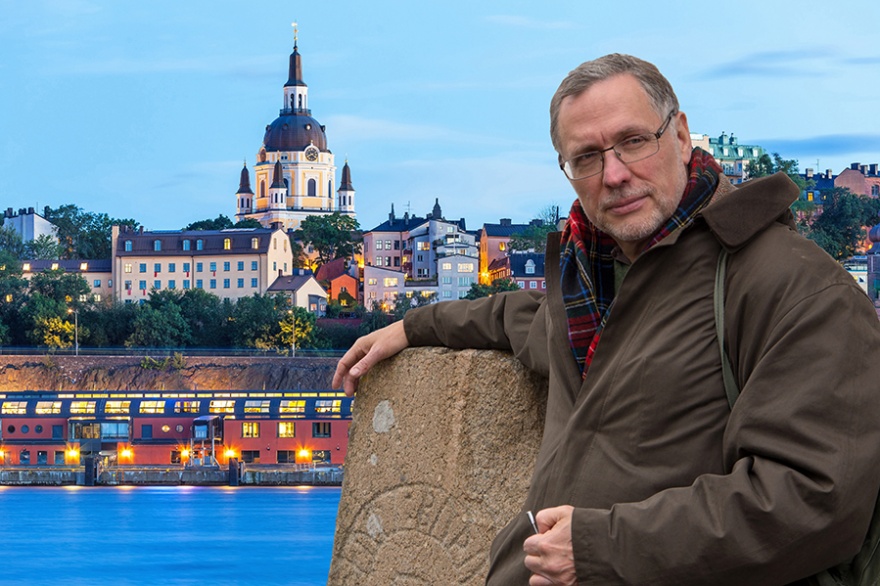Henrik Williams at Uppsala University
Henrik Williams’ responsibilities include Old Swedish, Old Icelandic and runology. Recently he went on his eighth lecture tour in the USA in order to increase interest in runes and obtain resources for research. The primary aim is to modernise the rune database at Uppsala University and perhaps also to create a professorship in runology. The rune database is the largest one in the world and is a fantastic research tool.
Please tell us about your childhood and upbringing.
I was born in Kalmar, a town on the south-east coast of Sweden. I went to school there and started studying at Uppsala University in 1978. But first I spent a year in 1976 – 1977 in Ohio as an exchange student.
What factors or events triggered your decision to devote yourself to the study of runes?
That took quite a while, as a matter of fact. I had seen the occasional runestones in my youth. I thought they looked very boring. But when I started studying history and Scandinavian languages in Uppsala, I came in contact with runes and runestones again, because that is part of teaching the history of the Swedish language. Here again, I did not find them particularly interesting. It was not until 1983 when working as a teaching assistant at the University of Illinois Urbana-Champaign that I came into contact with a professor who was interested in the very oldest rune inscriptions. He made me realize how important these sources are for ancient history, and that is what kindled my interest. When I came back to Sweden, I started looking for a topic to write my dissertation on. I settled on runes and ended up writing my dissertation on Swedish runestones.
What is the origin of runes?
There are three basic candidates, because we can see in runes that they must have been copied from one of the Mediterranean alphabets – runes like R and T and I which look almost exactly the same as capital letters in use now. It could be either the Greek alphabet or the Etruscan alphabet or the Roman alphabet. The most natural origin would be the Roman alphabet, because we were in close contact with the Romans around the birth of Christ, and the first inscriptions started appearing around 150 years after the birth of Christ.
What typical messages are written on runestones?
They all start the same, more or less. Such-and-such a person – sometimes more than one – raised or carved the stone after one or more other people died. Then they would specify the relationship: it could be the father or the mother, a brother or a sister, a son or a daughter, or a partner in trade. After this basic memorial formula three more messages would follow. One could be a prayer, e.g. “God help her soul.” The second message could be a signature, because towards the end of the Viking Age there were professional carvers who would sign their name. The third message could be an obituary of some kind, saying something about the dead person, like “He died in England.” Of course, there are always exceptions, but this is the basic message on a runestone.
Have any runestones been found in North America?
Yes, they have – around 20 or 30 stones. Some of those are modern, because we know who carved them. For example, there is a runestone in Minneapolis at the American Swedish Institute that was erected to commemorate a visit of some people from Uppsala. There are also inscriptions on stone that are not officially modern but are from the late 18th century or later. We have not found any really ancient stones that were left behind by Vikings, and we probably never will.
You travel a great deal and give lectures abroad. In which areas do you feel Sweden contributes most globally?
I would say that Sweden has contributed ideologically after WWII and even before. People in Sweden think that they are very normal, and that is not right. We are the most secular country in the world, and yet we have this social standard. We have much greater equality than in many other countries. The idea that you can have a society where a free market economy is combined with human rights, openness, tolerance and relatively few poor people should be promoted in the rest of the world. Our particular brand of democracy is probably our most valuable contribution.
How do you think the image of Sweden is changing and developing internationally and particularly in North America?
Unfortunately, there has been a veryconscious effort in foreign social media to sully the image of Sweden. This is not completely new. President Eisenhower once stated that Sweden may be very successful in many areas, but also has the world’s highest rate of suicides. That happened to be completely “fake news.” He later apologized for it, but that was only after he had stepped down as President. The rumour has nevertheless persisted for over half a century. Similarly, under President Trump it is claimed that there are areas in Sweden where you cannot go because they are unsafe, and that we have a variety of other huge problems. Some of it is exaggerated, and other things are a complete lie. Even when the reports are true, they are used for sinister purposes to advance other agendas. This I find unsettling, because it is not only bad for our country, but it is also bad for democracy. We know too little about each other, and what we do know is blown out of proportion and is nearly always negative.
How do you think Sweden has achieved the success it has despite being such a small country, population-wise? Any links to our Viking past?
I think there are four major factors. One of them is that Sweden has enjoyed peace for 200 years by now. This has enormous implications, because if you don’t have to fight, you conserve not only resources but also social equanimity by not feeling constantly under threat. The second factor is democracy. Sweden has a very long tradition of some kind of democracy, even going back to the “Thing” assemblies during the Viking Age – a kind of early parliament. Thirdly, the King never had absolute power in Sweden, in contrast to many other countries. Lastly, the role women played in Sweden during the Viking Age and later was more prominent than in some countries even today.
What aspects of Swedish culture and life are you personally most passionate about promoting?
Since I am a linguistic historian, I do love talking about Sweden’s past, and especially the Viking Age. As a runologist, runic inscriptions are very close to my heart, because they have not been utilized nearly enough to convey a true picture of the Viking Age. Historians, archaeologists and others have been using the Icelandic sagas to tell stories about Swedish Vikings, even though much in there is wrong. I can’t understand why one would ignore the only original sources we have from that age. That is what I am passionate about – bringing out true knowledge and un-fake news about what really happened back in those days.
Are there any other current or upcoming projects or events that you would like to mention?
The greatest runestone in the world is the Rök stone in the Province of Östergötland, not far from the city of Linköping. It is from around the year 800, the very beginning of the Viking age. It is a huge monument, about 14 ft high, standing 8 ft above the ground, and covered with over 760 runes. Up until recently, nobody had succeeded in proposing a convincing interpretation, but I have been part of a four-professor team that has worked for two years on doing just that. The team consists of an archaeologist, an historian of religion, and a colleague of mine who is an expert in social semiotics and is very much into the theory of text and its communicative powers. It has been a pleasure and a privilege to work with these people. We have just submitted our new interpretation to an international journal which I think will change fundamentally our understanding of the early Viking Age, and especially the religious environment at that time. Unfortunately, I cannot tell you what the solution is pending publication, but it is a very exciting project!
Interviewed by Peter Berlin
First published May 10, 2019





